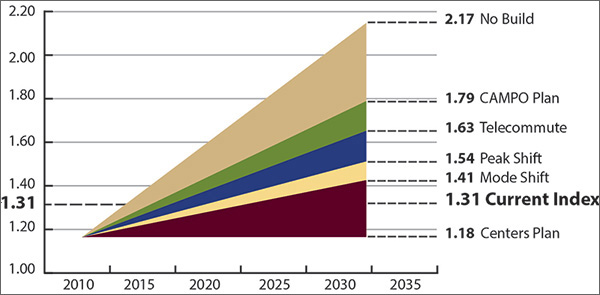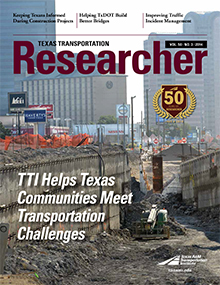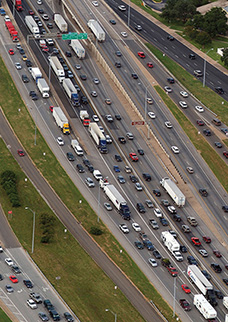In its 2013 Mobility Report, the Austin Chamber of Commerce makes extensive use of a study by the Texas A&M Transportation Institute (TTI) that models a strategy scenario designed to address the region’s mobility challenges.
TTI Research Scientist Tom Williams, Senior Research Engineer Ginger Goodin and Research Specialist Byron Chigoy were responsible for the study, which illustrates the individual and cumulative effects of five strategies aimed at reducing Austin’s Travel Time Index. The index measures the difference between travel during congested and uncongested times. Austin’s current index of 1.31 indicates a trip in congested conditions requires 31 percent more time than the same trip in uncongested conditions. Austin-region travel delay has roughly doubled since 1994, when the index was 1.16.
“The Austin Chamber engaged the Texas A&M Transportation Institute to model a scenario of strategies to mitigate traffic congestion,” the report states. “This report provides greater detail on the findings, but one conclusion is certain: there is no single strategy that will reduce traffic by itself. Each strategy builds upon another in a comprehensive manner to reduce traffic.”
The TTI study forecasts what the index could be in 2035, depending on whether specific strategies are adopted. If no steps are taken and no additional capacity is built, the index would climb to 2.17, meaning that a trip during congested hours would require more than twice the time needed for the same trip taken off-peak. Applying a combination of strategies could reduce the anticipated delay, step by step. Those strategies include:
- adopting the Capital Area Metropolitan Planning Organization’s (CAMPO’s) 2035 plan, containing improvements and expansion of both roadways and transit, and adding two managed lanes to I-35, which would result in an index of 1.79;
- increasing the proportion of the regional workforce that is telecommuting by 10 percent, which would limit the growth of the index to 1.63;
- shifting the time of travel outside of the routinely congested periods (peak shift), which would result in an index of 1.54; and
- removing an additional 11 percent of single-occupant vehicles from roadways by changing modes to walking, biking or transit (mode shift), which would result in an index of 1.41.

Each of these strategies would limit the degree to which the index would worsen over the next two decades. Adding yet one more strategy would actually bring the index below the current 1.31 level. That approach would involve a mixture of land-use development approaches that create residential and employment “centers” in which people live much closer to where they work, shop and recreate. The above strategies and the centers plan together could potentially lower the index to 1.18 — reflecting traffic conditions similar to those in the early 1990s.
The value of each strategy is an estimate and not intended to be a precise prediction, and the values will vary from one urban area to another, depending on local conditions. Ultimately, researchers say, the model can help decision makers and travelers understand the concept of an “all of the above” approach to mobility improvement like the one embraced by Austin business leaders.
“The reality is that there are many trip-reducing strategies that can help reduce congestion in addition to those modeled in this study,” says Williams. “But there are some key messages this study conveys: First, the solutions to congestion lie in both capacity improvements and demand reduction. Next, there’s a timeline to this problem. And finally, the wedge chart helps to compare the levels at which each strategy can be effective at reducing roadway congestion. This helps the region set its sights on effective goals.
“The Austin Chamber clearly sees the link between transportation efficiency and economic prosperity,” continues Williams. “We’re eager to continue the work that will help inform the policy discussions that Austin’s business leaders are now advancing.”

